Current and Future Trends of Information Technology and Sustainability in Logistics Outsourcing
Abstract
:1. Introduction
2. Literature Review
2.1. Logistics Outsourcing
2.1.1. Relationship Management
2.1.2. LSP Selection Criteria
2.1.3. Contract Management
2.1.4. In-House vs. Outsourcing Mix
2.2. Sustainability in Logistics Outsourcing
2.3. Technology in Logistics Outsourcing
3. Methods
4. Results
4.1. Performance Analysis
4.1.1. Publications Per Journal
4.1.2. Total Citations and Impact Per Journal
4.1.3. Source Growth
4.1.4. Influential Authors
4.1.5. Author Affiliations
4.1.6. Contribution by Country
4.2. Science Mapping
4.2.1. Co-Citations
4.2.2. Co-Word Analysis
4.2.3. Co-Occurrence Network
4.3. Emerging Themes and Trends
4.3.1. Environmental Sustainability
4.3.2. Cost Reduction
4.3.3. Sustainable Supply Chains
4.3.4. Information Technology and Innovation
4.3.5. Risk Management
4.3.6. Reverse Logistics
5. Discussion and Conclusions
Managerial Implications
Funding
Institutional Review Board Statement
Data Availability Statement
Conflicts of Interest
References
- Lou, Y.; Feng, L.; He, S.; He, Z.; Zhao, X. Logistics service outsourcing choices in a retailer-led supply chain. Transp. Res. Part E Logist. Transp. Rev. 2020, 141, 101944. [Google Scholar] [CrossRef]
- Gao, T.; Erokhin, V.; Arskiy, A. Dynamic optimization of fuel and logistics costs as a tool in pursuing economic sustainability of a farm. Sustainability 2019, 11, 5463. [Google Scholar] [CrossRef] [Green Version]
- Akbari, M. Logistics outsourcing: A structured literature review. Benchmarking 2018, 25, 1548–1580. [Google Scholar] [CrossRef]
- Tamás, P. Innovative business model for realization of sustainable supply chain at the outsourcing examination of logistics services. Sustainability 2018, 10, 210. [Google Scholar] [CrossRef] [Green Version]
- Mageto, J.; Prinsloo, G.; Luke, R. The extent of logistics outsourcing among small and medium-sized manufacturing enterprises in Nairobi. J. Transp. Supply Chain Manag. 2018, 12, 1–9. [Google Scholar] [CrossRef]
- Langley, J.C., Jr. 2010 Third-Party Logistics. 2010, p. 52. Available online: https://www.capgemini.com/se-en/resources/2010-third-party-logistics-study-fast-moving-consumer-goods-industry/ (accessed on 15 March 2022).
- Langley, J.C., Jr.; Capgemini. 2016 Third-Party Logistics Study. 2016, p. 56. Available online: http://www.3plstudy.com/media/downloads/2015/09/3pl_report-final_reduced_size.pdf (accessed on 14 March 2022).
- Langley, J.C., Jr.; NTT DATA. Third-Party Logistics Study Results and Findings of the 26th Annual Study. 2022. Available online: https://www.3plstudy.com/ntt3pl/nttds_3pl.nttds_2022_3pl (accessed on 13 March 2022).
- Mageto, J.; Prinsloo, G.; Luke, R. Determinants of logistics outsourcing performance among small and medium enterprises. Int. J. Logist. Syst. Manag. 2020, 35, 541–565. [Google Scholar] [CrossRef]
- Gardas, B.B.; Raut, R.D.; Narkhede, B.E. Analysing the 3PL service provider’s evaluation criteria through a sustainable approach. Int. J. Product. Perform. Manag. 2019, 68, 958–980. [Google Scholar] [CrossRef]
- Abdel-Basset, M.; Gamal, A.; Elhoseny, M.; Chakrabortty, R.; Ryan, M. A conceptual hybrid approach from a multicriteria perspective for sustainable third-party reverse logistics provider identification. Sustainability 2021, 13, 4615. [Google Scholar] [CrossRef]
- 2014 Third-Party Logistics Study: The State of Logistics Outsourcing 2014; Big Data in 3PL-Customer Relationships; Capgemini Consulting: Paris, France; Penn State University: State College, PA, USA; Penske Truck Leasing & Penske Logistics: State College, PA, USA; KONN/FERRY International: Los Angeles, CA, USA; Eye For Transport: College Park, GA, USA, 2014; pp. 16–23.
- Rajeev, A.; Pati, R.K.; Padhi, S.; Govindan, K. Evolution of sustainability in supply chain management: A literature review. J. Clean. Prod. 2017, 162, 299–314. [Google Scholar] [CrossRef]
- Govindan, K.; Soleimani, H.; Kannan, D. Reverse logistics and closed-loop supply chain: A comprehensive review to explore the future. Eur. J. Oper. Res. 2015, 240, 603–626. [Google Scholar] [CrossRef] [Green Version]
- Davydenko, I.; Hopman, M.; Fransen, R.; Harmsen, J. Mass-Balance Method for Provision of Net Zero Emission Transport Services. Sustainability 2022, 14, 6125. [Google Scholar] [CrossRef]
- Lallanilla, M. Greenhouse gases: Causes, sources and environmental effects. Live Sci. 2019, 20, 2020. Available online: www.livescience.com/37821-greenhouse-gases.html (accessed on 20 March 2022).
- Mageto, J. Big data analytics in sustainable supply chain management: A focus on manufacturing supply chains. Sustainability 2021, 13, 7101. [Google Scholar] [CrossRef]
- Chalmeta, R.; Santos-Deleón, N.J. Sustainable supply chain in the era of industry 4.0 and big data: A systematic analysis of literature and research. Sustainability 2020, 12, 4108. [Google Scholar] [CrossRef]
- Aguezzoul, A. Third-party logistics selection problem: A literature review on criteria and methods. Omega 2014, 49, 69–78. [Google Scholar] [CrossRef]
- Rajagopal, P.; Pandiyan, V.; Sundram, K.; Naidu, B.M. Future Directions of Reverse Logistics in Gaining Competitive Advantages: A Review of Literature. 2015. Available online: http://excelingtech.co.uk/ (accessed on 21 March 2022).
- Işiklar, G.; Alptekin, E.; Büyüközkan, G. Application of a hybrid intelligent decision support model in logistics outsourcing. Comput. Oper. Res. 2007, 34, 3701–3714. [Google Scholar] [CrossRef]
- Gong, F.; Kung, D.S.; Zeng, T. The impact of different contract structures on IT investment in logistics outsourcing. Int. J. Prod. Econ. 2018, 195, 158–167. [Google Scholar] [CrossRef]
- Monnet, M. The Intermediary Conditions of Logistics Service Providers in the Context of Sustainable Development. Supply Chain. Forum Int. J. 2008, 9, 78–87. [Google Scholar] [CrossRef]
- Facanha, C.; Horvath, A. Environmental Assessment of Logistics Outsourcing. J. Manag. Eng. 2005, 21, 27–37. [Google Scholar] [CrossRef]
- König, A.; Spinler, S. The effect of logistics outsourcing on the supply chain vulnerability of shippers: Development of a conceptual risk management framework. Int. J. Logist. Manag. 2016, 27, 122–141. [Google Scholar] [CrossRef]
- Ali, S.S.; Kaur, R. An analysis of satisfaction level of 3PL service users with the help of ACSI. Benchmarking 2018, 25, 24–46. [Google Scholar] [CrossRef]
- Barker, J.M.; Gibson, A.R.; Hofer, A.R.; Hofer, C.; Moussaoui, I.; Scott, M.A. A competitive dynamics perspective on the diversification of third-party logistics providers’ service portfolios. Transp. Res. Part E Logist. Transp. Rev. 2021, 146, 102219. [Google Scholar] [CrossRef]
- Marchet, G.; Marco, M.; Sara, P.; Chiara, S. Types of logistics outsourcing and related impact on the 3PL buying process: Empirical evidence. J. Logist. Syst. Manag. 2018, 30, 139–161. [Google Scholar] [CrossRef]
- Sinkovics, R.R.; Kuivalainen, O.; Roath, A.S. Value co-creation in an outsourcing arrangement between manufacturers and third party logistics providers: Resource commitment, innovation and collaboration. J. Bus. Ind. Mark. 2018, 33, 563–573. [Google Scholar] [CrossRef]
- Lieb, R.; Miller, J. The Use of Third-Party Logistics Services by Large American Manufacturers. J. Bus. Logist. 2015, 13, 1–12. [Google Scholar] [CrossRef]
- Prajapati, H.; Kant, R.; Shankar, R. Selection of strategy for reverse logistics implementation. J. Glob. Oper. Strateg. Sourc. 2021. [Google Scholar] [CrossRef]
- Peng, J. Selection of Logistics Outsourcing Service Suppliers Based on AHP. Energy Procedia 2012, 17, 595–601. [Google Scholar] [CrossRef] [Green Version]
- Kahraman, C.; Ateş, N.Y.; Çevik, S.; Gülbay, M.; Erdoğan, S.A. Hierarchical fuzzy TOPSIS model for selection among logistics information technologies. J. Enterp. Inf. Manag. 2007, 20, 143–168. [Google Scholar] [CrossRef]
- Shi, J.; Park, Y.; Sugie, R.; Fukuzawa, M. Long-Term Partnerships in Japanese Firms’ Logistics Outsourcing: From a Sustainable Perspective. Sustainability 2022, 14, 6376. [Google Scholar] [CrossRef]
- Hwang, T.; Kim, S.T. Balancing in-house and outsourced logistics services: Effects on supply chain agility and firm performance. Serv. Bus. 2019, 13, 531–556. [Google Scholar] [CrossRef]
- Seroka-Stolka, O. Green Initiatives in Environmental Management of Logistics Companies. Transp. Res. Procedia 2016, 16, 483–489. [Google Scholar] [CrossRef] [Green Version]
- Agrawal, S.; Singh, R.K.; Murtaza, Q. A literature review and perspectives in reverse logistics. Resour. Conserv. Recycl. 2015, 97, 76–92. [Google Scholar] [CrossRef]
- Akbari, M.; McClelland, R. Corporate social responsibility and corporate citizenship in sustainable supply chain: A structured literature review. Benchmarking 2020, 27, 1799–1841. [Google Scholar] [CrossRef]
- Sharma, R.; Kamble, S.S.; Gunasekaran, A.; Kumar, V.; Kumar, A. A systematic literature review on machine learning applications for sustainable agriculture supply chain performance. Comput. Oper. Res. 2020, 119, 104926. [Google Scholar] [CrossRef]
- Midgley, J.; Bak, O. A preliminary investigation into senior management skills: The context of third-party logistics (3PLs) providers. Benchmarking 2021. [Google Scholar] [CrossRef]
- Malviya, R.K.; Kant, R. Green supply chain management (GSCM): A structured literature review and research implications. Benchmarking 2015, 22, 1360–1394. [Google Scholar] [CrossRef]
- Nagariya, R.; Kumar, D.; Kumar, I. Service supply chain: From bibliometric analysis to content analysis, current research trends and future research directions. Benchmarking 2021, 28, 333–369. [Google Scholar] [CrossRef]
- Akbari, M.; Do, T.N.A. A systematic review of machine learning in logistics and supply chain management: Current trends and future directions. Benchmarking 2021, 28, 2977–3005. [Google Scholar] [CrossRef]
- Abbasi, A.; Sarker, S.; Chiang, R.H.L.; Lindner, C.H. Big data research in information systems: Toward an inclusive research agenda. J. Assoc. Inf. Syst. 2013, 17, 3. [Google Scholar] [CrossRef] [Green Version]
- Saglietto, L. Bibliometric analysis of sharing economy logistics and crowd logistics. Int. J. Crowd Sci. 2021, 5, 31–54. [Google Scholar] [CrossRef]
- Pham, M.T.; Rajić, A.; Greig, J.D.; Sargeant, J.M.; Papadopoulos, A.; Mcewen, S.A. A scoping review of scoping reviews: Advancing the approach and enhancing the consistency. Res. Synth. Methods 2014, 5, 371–385. [Google Scholar] [CrossRef]
- Ren, R.; Hu, W.; Dong, J.; Sun, B.; Chen, Y.; Chen, Z. A systematic literature review of green and sustainable logistics: Bibliometric analysis, research trend and knowledge taxonomy. Int. J. Environ. Res. Public Health 2020, 17, 261. [Google Scholar] [CrossRef] [Green Version]
- Grzybowska, K.; Awasthi, A. Literature Review on Sustainable Logistics and Sustainable Production for Industry 4.0. In Sustainable Logistics and Production in Industry 4.0; Springer: Cham, Switzerland, 2020; pp. 1–18. [Google Scholar] [CrossRef]
- Donthu, N.; Kumar, S.; Mukherjee, D.; Pandey, N.; Lim, W.M. How to conduct a bibliometric analysis: An overview and guidelines. J. Bus. Res. 2021, 133, 285–296. [Google Scholar] [CrossRef]
- Baas, J.; Schotten, M.; Plume, A.; Côté, G.; Karimi, R. Scopus as a curated, high-quality bibliometric data source for academic research in quantitative science studies. Quant. Sci. Stud. 2020, 1, 377–386. [Google Scholar] [CrossRef]
- Wamba, S.F.; Bawack, R.E.; Guthrie, C.; Queiroz, M.M.; Carillo, K.D.A. Are we preparing for a good AI society? A bibliometric review and research agenda. Technol. Forecast. Soc. Chang. 2021, 164, 120482. [Google Scholar] [CrossRef]
- Zhang, Y.; Huang, Y.; Porter, A.L.; Zhang, G.; Lu, J. Discovering and forecasting interactions in big data research: A learning-enhanced bibliometric study. Technol. Forecast. Soc. Chang. 2019, 146, 795–807. [Google Scholar] [CrossRef]
- Hirsch, J.E. An Index to Quantify an Individual’s Scientific Research Output. 2005. Available online: https://www.pnas.org/doi/full/10.1073/pnas.0507655102 (accessed on 21 March 2022).
- Huge-Brodin, M.; Sweeney, E.; Evangelista, P. Environmental alignment between logistics service providers and shippers—A supply chain perspective. Int. J. Logist. Manag. 2020, 31, 575–605. [Google Scholar] [CrossRef]
- Cobo, M.J.; López-Herrera, A.G.; Herrera-Viedma, E.; Herrera, F. An approach for detecting, quantifying, and visualizing the evolution of a research field: A practical application to the Fuzzy Sets Theory field. J. Informetr. 2011, 5, 146–166. [Google Scholar] [CrossRef]
- Callon, M.; Courtial, J.P.; Laville, F. Co-Word Analysis as a Tool For Describing the Network of Interactions between Basic and Technological Research: The Case of Polymer Chemistry. Scientometrics 1991, 22, 155–205. [Google Scholar] [CrossRef]
- Hazen, B.T.; Skipper, J.B.; Ezell, J.D.; Boone, C.A. Big data and predictive analytics for supply chain sustainability: A theory-driven research agenda. Comput. Ind. Eng. 2016, 101, 592–598. [Google Scholar] [CrossRef]
- Seuring, S.; Müller, M. Core issues in sustainable supply chain management—A Delphi study. Bus. Strategy Environ. 2008, 17, 455–466. [Google Scholar] [CrossRef]
- Gupta, A.; Singh, R.K. Managing operations by a logistics company for sustainable service quality: Indian perspective. Manag. Environ. Qual. Int. J. 2020, 31, 1309–1327. [Google Scholar] [CrossRef]
- Lan, S.; Tseng, M.L.; Yang, C.; Huisingh, D. Trends in sustainable logistics in major cities in China. Sci. Total Environ. 2020, 712, 136381. [Google Scholar] [CrossRef]
- Jabbour, C.J.C.; Fiorini, P.D.C.; Ndubisi, N.O.; Queiroz, M.M.; Piato, É.L. Digitally-enabled sustainable supply chains in the 21st century: A review and a research agenda. Sci. Total Environ. 2020, 725, 138117. [Google Scholar] [CrossRef]
- Wong, C.Y.; Wong, C.W.Y.; Boon-Itt, S. Integrating environmental management into supply chains: A systematic literature review and theoretical framework. Int. J. Phys. Distrib. Logist. Manag. 2015, 45, 43–68. [Google Scholar] [CrossRef]
- Yildiz, T. An Empirical Analysis on Logistics Performance and the Global Competitiveness. Bus. Theory Pract. 2017, 18, 1–13. [Google Scholar] [CrossRef]
- Carter, C.R.; Easton, P.L. Sustainable supply chain management: Evolution and future directions. Int. J. Phys. Distrib. Logist. Manag. 2011, 41, 46–62. [Google Scholar] [CrossRef]
- Solakivi, T.; Töyli, J.; Ojala, L. Logistics outsourcing, its motives and the level of logistics costs in manufacturing and trading companies operating in Finland. Prod. Plan. Control. 2013, 24, 388–398. [Google Scholar] [CrossRef]
- Carter, C.R.; Rogers, D.S. A framework of sustainable supply chain management: Moving toward new theory. Int. J. Phys. Distrib. Logist. Manag. 2008, 38, 360–387. [Google Scholar] [CrossRef]
- Wang, C.N.; Nguyen, N.A.T.; Dang, T.T.; Lu, C.M. A compromised decision-making approach to third-party logistics selection in sustainable supply chain using fuzzy ahp and fuzzy vikor methods. Mathematics 2021, 9, 886. [Google Scholar] [CrossRef]
- Wang, Y.; Ma, X.; Lao, Y.; Wang, Y. A fuzzy-based customer clustering approach with hierarchical structure for logistics network optimization. Expert Syst. Appl. 2014, 41, 521–534. [Google Scholar] [CrossRef]
- Soh, S. A decision model for evaluating third-party logistics providers using fuzzy analytic hierarchy process. Afr. J. Bus. Manag. 2010, 4, 339–349. Available online: http://www.academicjournals.org/AJBM (accessed on 21 March 2022).
- Choi, T.M.; Chiu, C.H.; Chan, H.K. Risk management of logistics systems. Transp. Res. Part E Logist. Transp. Rev. 2016, 90, 1–6. [Google Scholar] [CrossRef]
- Lee, C.K.M.; Yeung, Y.C.; Hong, Z. An integrated framework for outsourcing risk management. Ind. Manag. Data Syst. 2012, 112, 541–558. [Google Scholar] [CrossRef] [Green Version]
- Akter, N.; Chhetri, P.; Rahman, S. Understanding the usage patterns, practices and decision process of third party logistics outsourcing in Bangladesh. J. Glob. Oper. Strateg. Sourc. 2019, 12, 329–354. [Google Scholar] [CrossRef]
- Rahman, S. An exploratory study of outsourcing 3PL services: An Australian perspective. Benchmarking 2011, 18, 342–358. [Google Scholar] [CrossRef]
- Zarbakhshnia, N.; Wu, Y.; Govindan, K.; Soleimani, H. A novel hybrid multiple attribute decision-making approach for outsourcing sustainable reverse logistics. J. Clean. Prod. 2020, 242, 118461. [Google Scholar] [CrossRef]
- Govindan, K.; Kaliyan, M.; Kannan, D.; Haq, A.N. Barriers analysis for green supply chain management implementation in Indian industries using analytic hierarchy process. Int. J. Prod. Econ. 2014, 147, 555–568. [Google Scholar] [CrossRef]
- Giri, B.C.; Dey, S.K. Game theoretic models for a closed-loop supply chain with stochastic demand and backup supplier under dual channel recycling. Decis. Mak. Appl. Manag. Eng. 2020, 3, 108–125. [Google Scholar] [CrossRef]
- Kumar, P.; Singh, R.K.; Kumar, V. Managing supply chains for sustainable operations in the era of industry 4.0 and circular economy: Analysis of barriers. Resour. Conserv. Recycl. 2021, 164, 105215. [Google Scholar] [CrossRef]
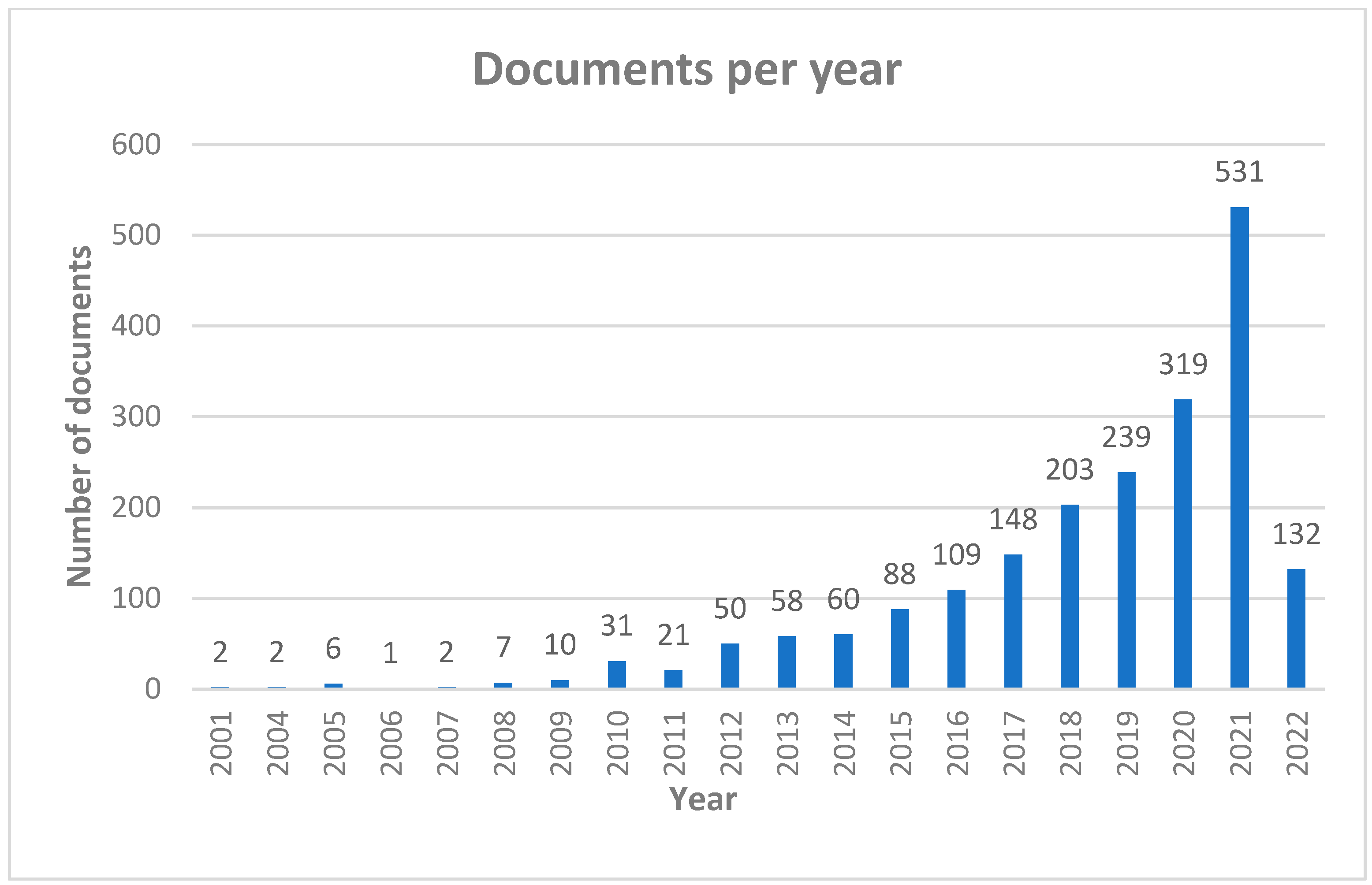

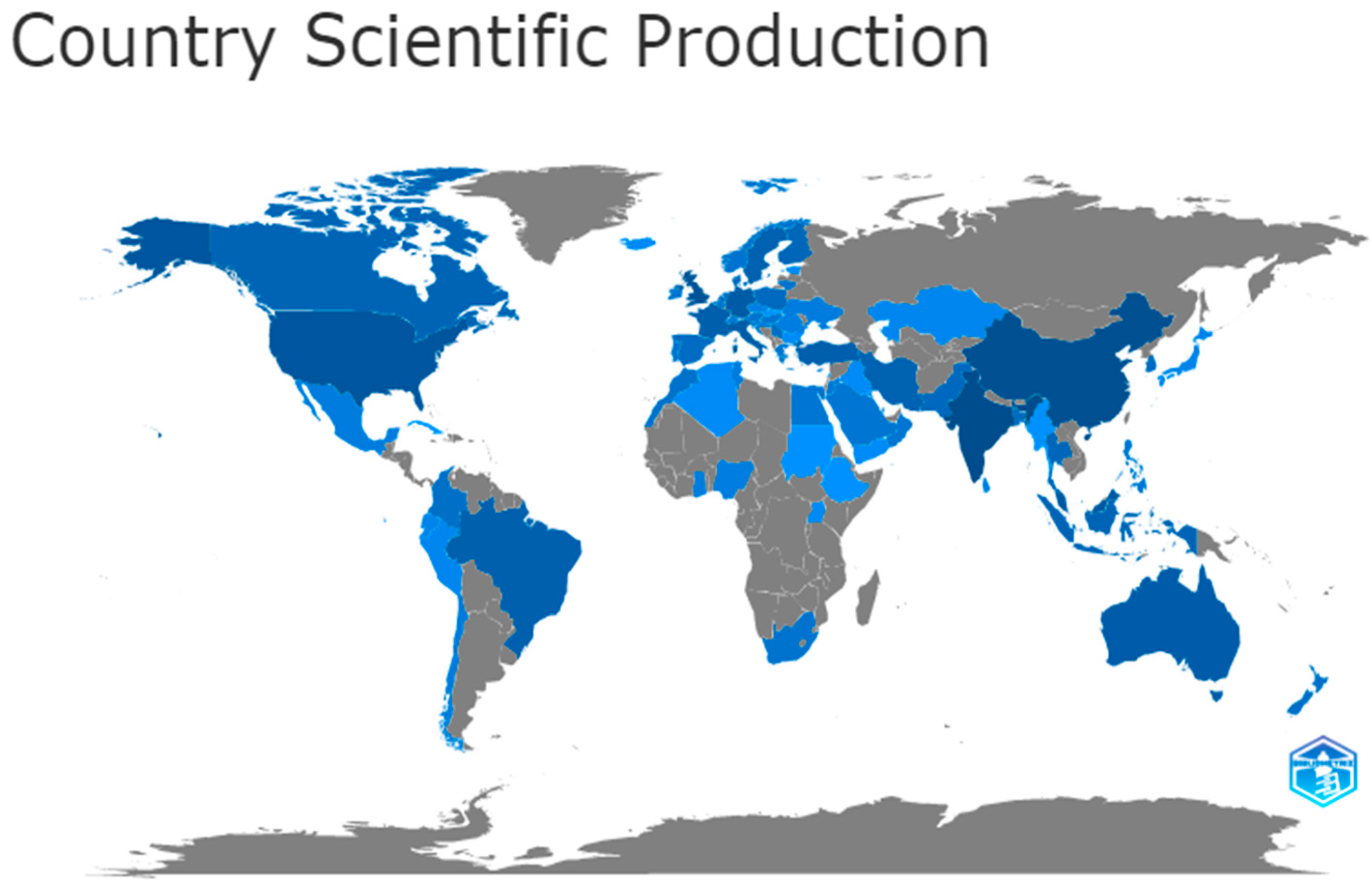
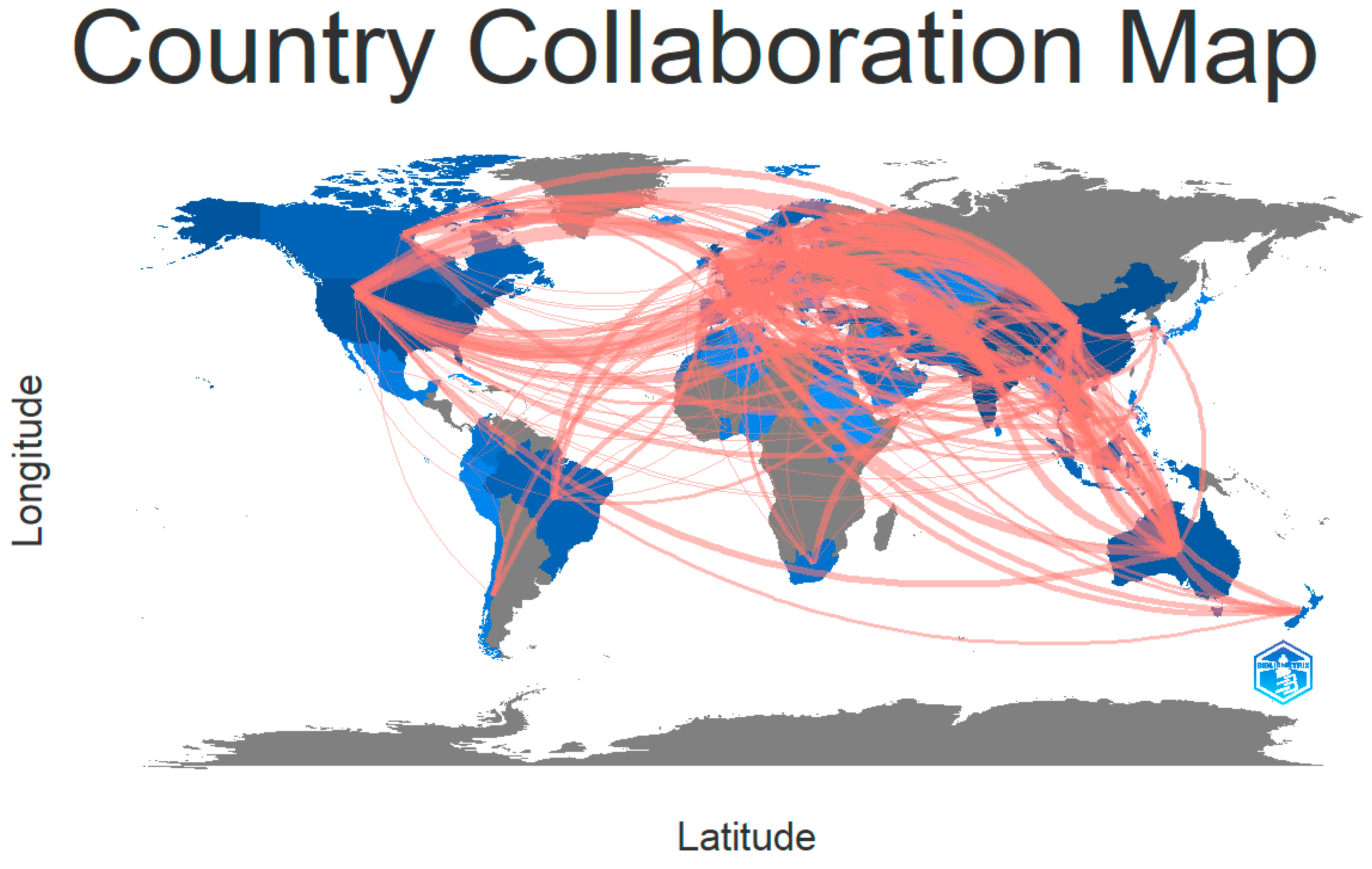
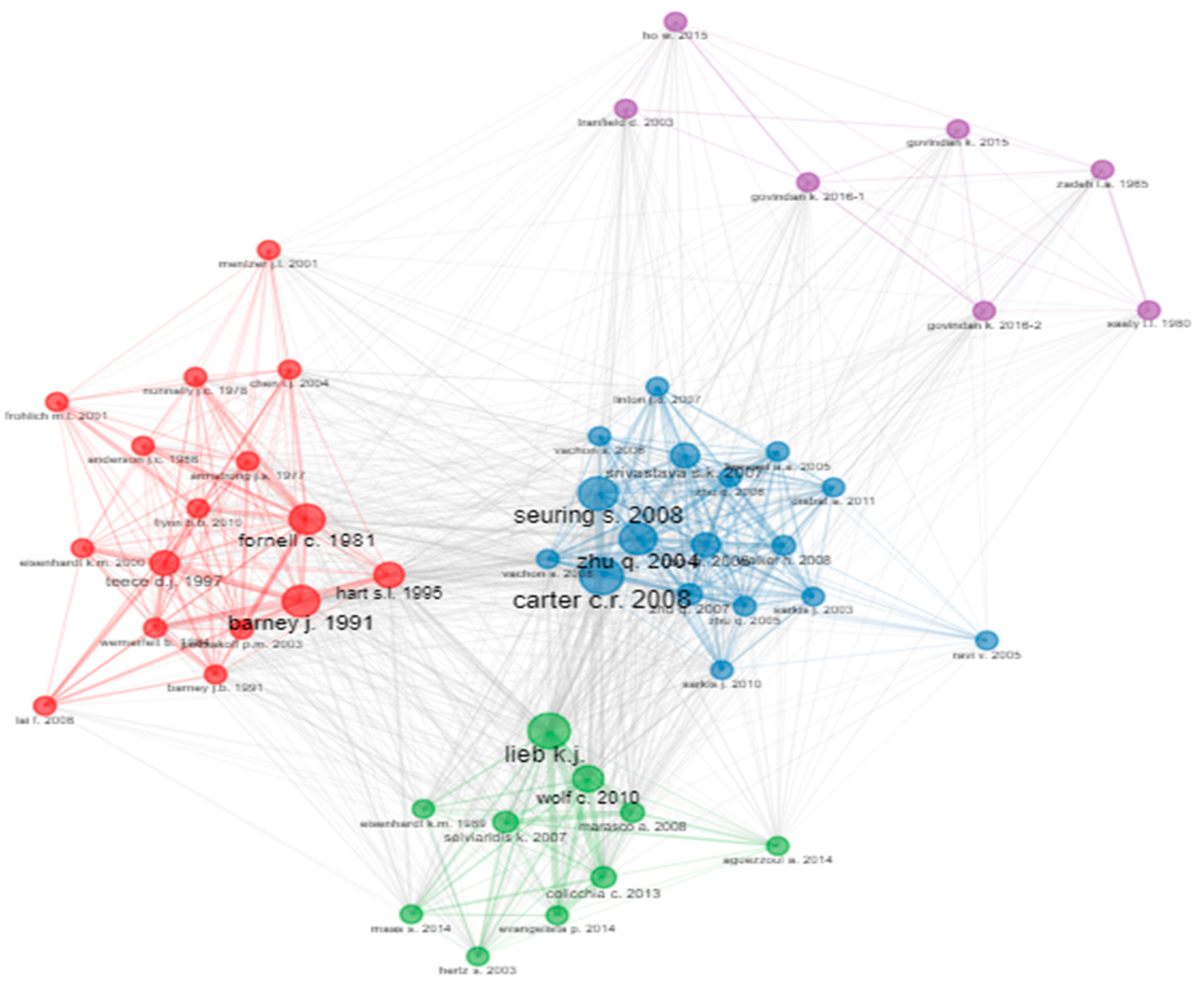
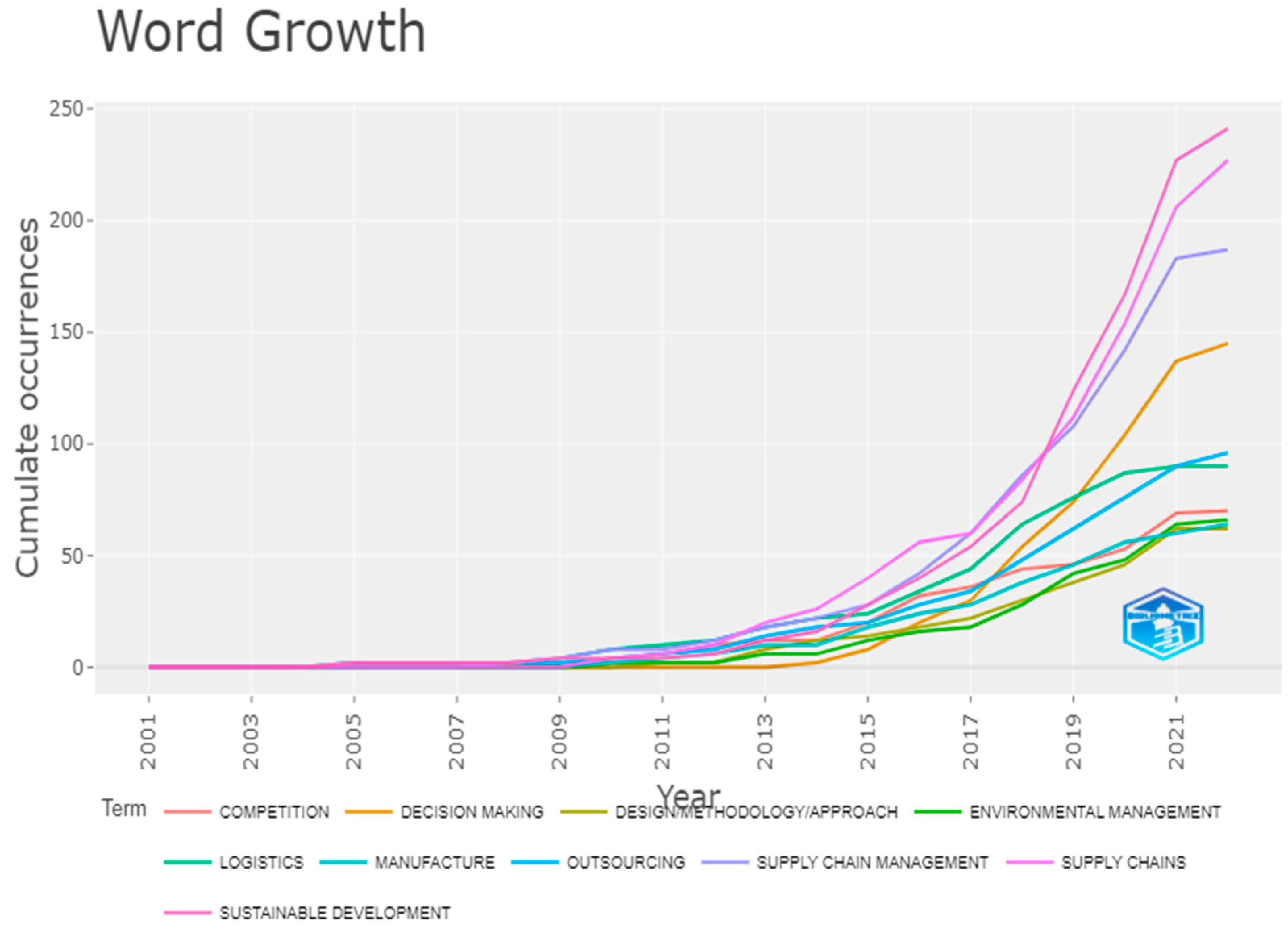
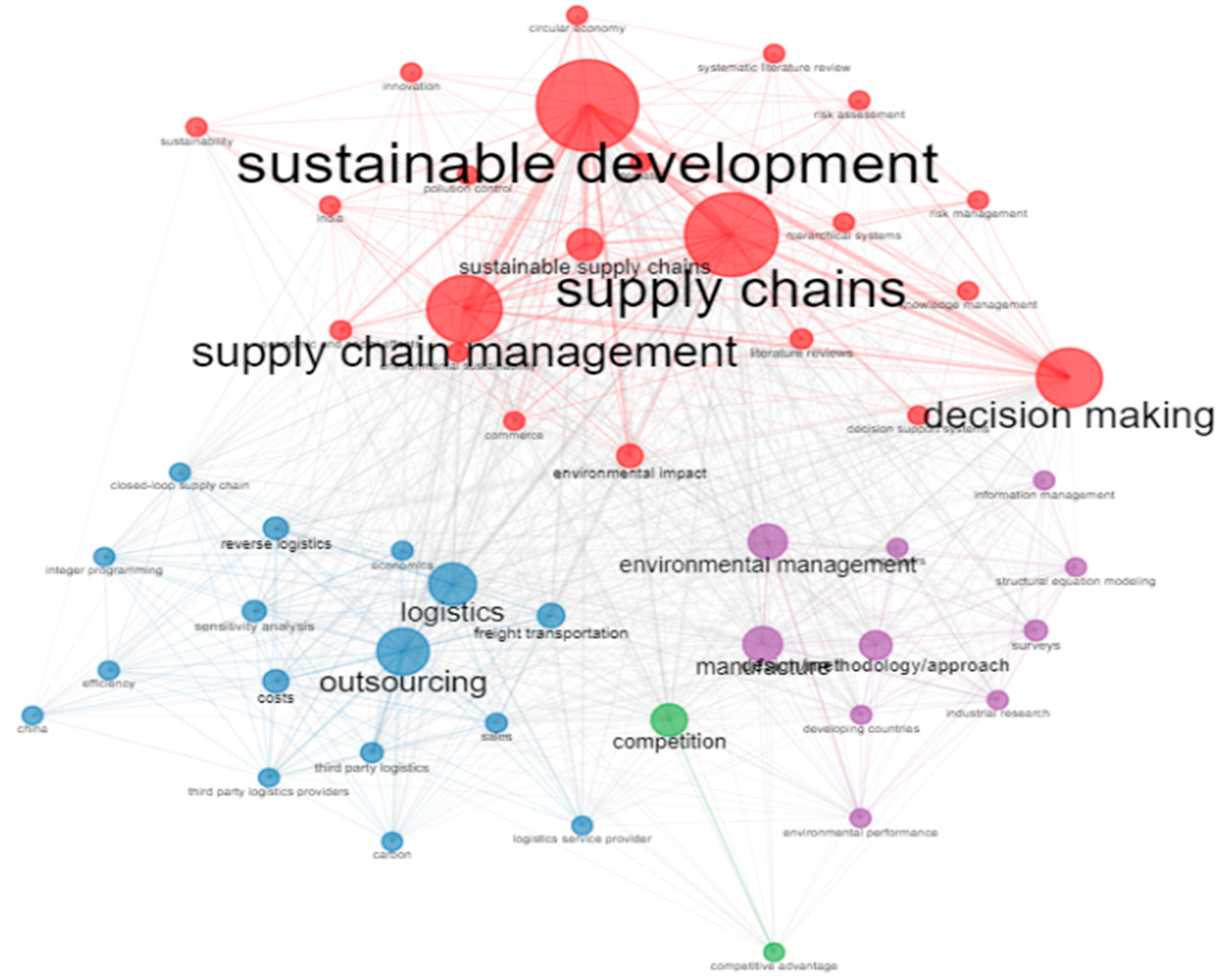
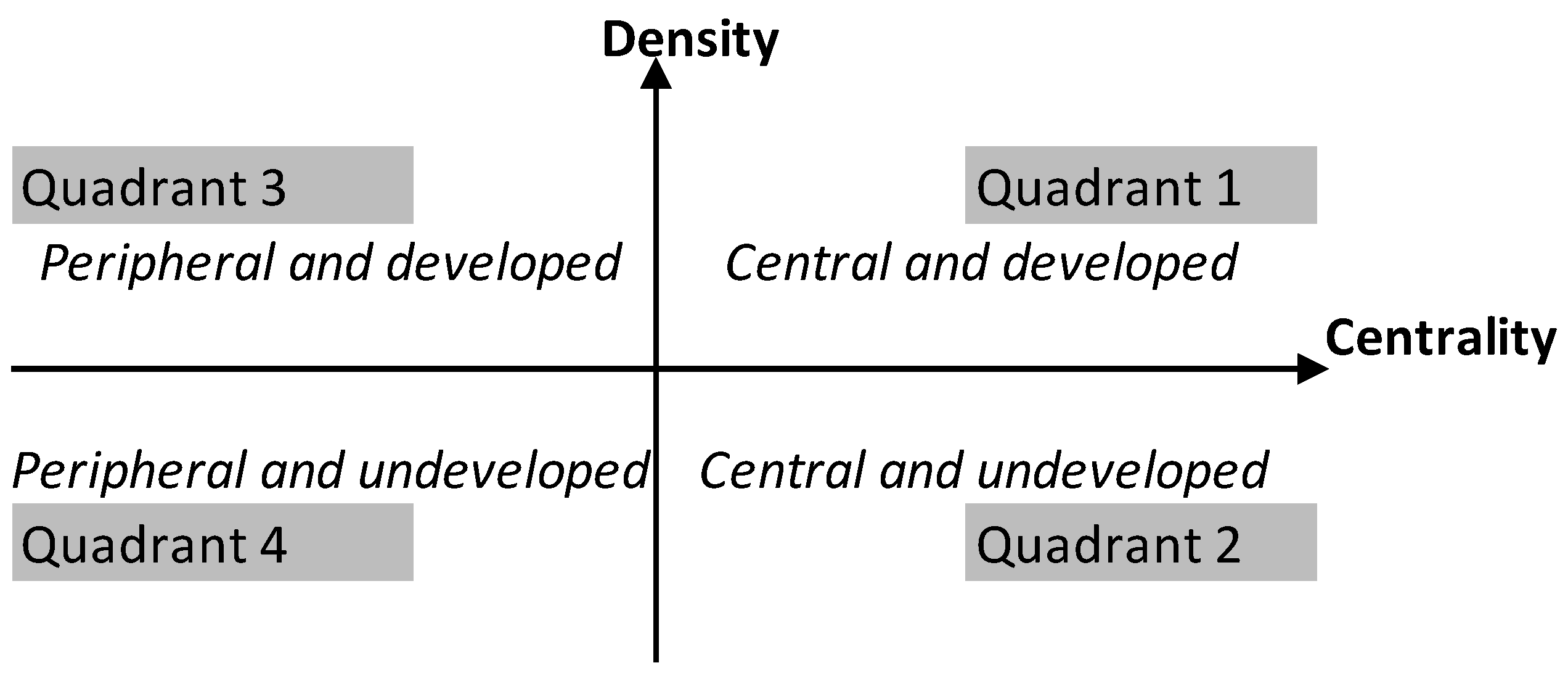
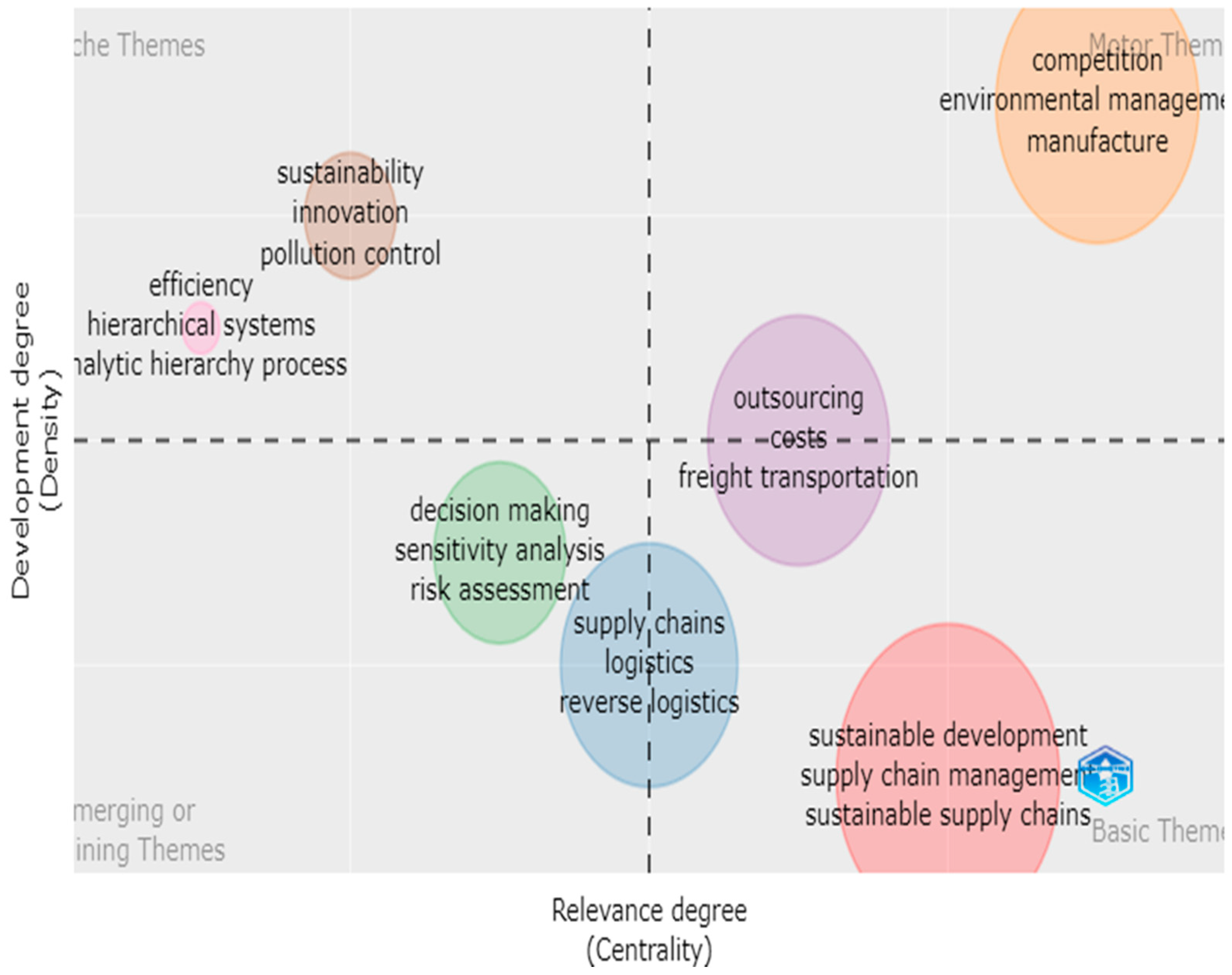
| Description | Results |
|---|---|
| Main information about data | |
| Timespan | 2001:2022 |
| Sources (Journals, Books, etc) | 280 |
| Documents | 2019 |
| Average years from publication | 3.6 |
| Average citations per documents | 22.11 |
| Average citations per year per doc | 3.96 |
| References | 91,330 |
| Document types | |
| article | 1702 |
| book chapter | 79 |
| conference paper | 101 |
| review | 137 |
| Document contents | |
| Keywords Plus (ID) | 2231 |
| Author’s Keywords (DE) | 3125 |
| Authors | |
| Authors | 2750 |
| Author Appearances | 6487 |
| Authors of single-authored documents | 81 |
| Authors of multi-authored documents | 2669 |
| Authors collaboration | |
| Single-authored documents | 153 |
| Documents per Author | 0.734 |
| Authors per Document | 1.36 |
| Co-Authors per Documents | 3.21 |
| Collaboration Index | 1.43 |
| Sources | Articles |
|---|---|
| Journal of Cleaner Production | 194 |
| International Journal of Logistics Management | 114 |
| International Journal of Production Economics | 82 |
| International Journal of Production Research | 76 |
| International Journal of Logistics Systems and Management | 72 |
| International Journal of Logistics Research and Applications | 64 |
| Benchmarking | 55 |
| International Journal of Physical Distribution and Logistics Management | 50 |
| International Journal of Supply Chain Management | 46 |
| Production Planning and Control | 46 |
| Transportation Research Part E: Logistics and Transportation Review | 44 |
| Industrial Management and Data Systems | 36 |
| Supply Chain Management | 36 |
| International Journal of Operations and Production Management | 34 |
| Journal Of Enterprise Information Management | 34 |
| Business Strategy and The Environment | 32 |
| Proceedings Of The International Conference On Industrial Engineering And Operations Management | 24 |
| International Journal of Services and Operations Management | 22 |
| International Journal of Productivity and Performance Management | 20 |
| Journal Of Modelling in Management | 20 |
| Element | h_Index | g_Index | m_Index | TC | NP | PY_Start |
|---|---|---|---|---|---|---|
| Benchmarking | 17 | 29 | 1.42 | 906 | 49 | 2011 |
| British Food Journal | 6 | 6 | 0.50 | 336 | 6 | 2011 |
| Asia Pacific Journal of Marketing and Logistics | 4 | 5 | 0.50 | 64 | 5 | 2015 |
| Bar–Brazilian Administration Review | 2 | 2 | 0.18 | 15 | 2 | 2012 |
| Baltic Journal of Management | 2 | 2 | 0.29 | 11 | 2 | 2016 |
| Asia-Pacific Journal of Business Administration | 2 | 2 | 0.67 | 8 | 2 | 2020 |
| Asian Business and Management | 2 | 2 | 0.50 | 8 | 2 | 2019 |
| Advances In Production Engineering and Management | 2 | 2 | 0.50 | 38 | 2 | 2019 |
| Advances In Business Marketing and Purchasing | 2 | 2 | 0.25 | 16 | 2 | 2015 |
| Academy Of Entrepreneurship Journal | 2 | 2 | 0.40 | 46 | 2 | 2018 |
| 2nd International Symposium On Technology Management and Emerging Technologies, Istmet 2015–Proceeding | 2 | 2 | 0.25 | 4 | 2 | 2015 |
| 2018 5th International Conference on Industrial Engineering and Applications, Iciea 2018 | 2 | 2 | 0.40 | 4 | 2 | 2018 |
| Best Practices in Manufacturing Processes: Experiences From Latin America | 1 | 1 | 0.20 | 2 | 2 | 2018 |
| Benchmarking: An International Journal | 1 | 1 | 0.09 | 4 | 1 | 2012 |
| Analyzing The Impacts of Industry 4.0 In Modern Business Environments | 1 | 1 | 0.20 | 2 | 2 | 2018 |
| Agri-Food Supply Chain Management: Breakthroughs in Research and Practice | 1 | 1 | 0.14 | 2 | 2 | 2016 |
| Administrative Sciences | 1 | 1 | 0.33 | 2 | 1 | 2020 |
| Academy Of Strategic Management Journal | 1 | 1 | 0.50 | 2 | 2 | 2021 |
| 2020 International Conference on Computer Science, Engineering and Applications, Iccsea 2020 | 1 | 1 | 0.33 | 2 | 2 | 2020 |
| 2019 16th International Conference on Service Systems and Service Management, Icsssm 2019 | 1 | 1 | 0.25 | 2 | 2 | 2019 |
| Element | h_Index | g_Index | m_Index | TC | NP | PY_Start |
|---|---|---|---|---|---|---|
| Gunasekaran A | 15 | 18 | 0.833 | 1950 | 18 | 2005 |
| Seuring S | 10 | 14 | 0.769 | 1602 | 14 | 2010 |
| Searcy C | 4 | 4 | 0.364 | 1506 | 4 | 2012 |
| Surti C | 2 | 2 | 0.182 | 1372 | 2 | 2012 |
| Hassini E | 2 | 2 | 0.182 | 1372 | 2 | 2012 |
| Govindan K | 18 | 18 | 2.571 | 1352 | 18 | 2016 |
| Luthra S | 15 | 25 | 2.143 | 1349 | 25 | 2016 |
| Mangla Sk | 17 | 23 | 2.429 | 1329 | 23 | 2016 |
| Perotti S | 11 | 16 | 0.917 | 1093 | 16 | 2011 |
| Gold S | 3 | 4 | 0.231 | 1084 | 4 | 2010 |
| Beske P | 2 | 2 | 0.154 | 1078 | 2 | 2010 |
| Ngai Ewt | 2 | 2 | 0.111 | 780 | 2 | 2005 |
| Kumar A | 17 | 25 | 2.429 | 690 | 31 | 2016 |
| Timor M | 2 | 2 | 0.154 | 686 | 2 | 2010 |
| Sipahi S | 2 | 2 | 0.154 | 686 | 2 | 2010 |
| Marchet G | 6 | 6 | 0.6 | 622 | 6 | 2013 |
| Marasco A | 2 | 2 | 0.133 | 600 | 2 | 2008 |
| Raut Rd | 13 | 22 | 2.167 | 567 | 22 | 2017 |
| Liao H | 8 | 13 | 2 | 557 | 13 | 2019 |
| Gardas Bb | 14 | 16 | 2.333 | 555 | 16 | 2017 |
| Papadopoulos T | 5 | 5 | 0.714 | 552 | 5 | 2016 |
| Wang Y | 6 | 6 | 0.75 | 536 | 6 | 2015 |
| Schultmann F | 4 | 4 | 0.571 | 534 | 4 | 2016 |
| Fröhling M | 4 | 4 | 0.571 | 534 | 4 | 2016 |
| Mishra N | 6 | 6 | 1.2 | 514 | 6 | 2018 |
| Melacini M | 5 | 5 | 0.417 | 511 | 5 | 2011 |
| Dubey R | 5 | 6 | 0.714 | 510 | 6 | 2016 |
| Knemeyer Am | 3 | 3 | 0.3 | 495 | 3 | 2013 |
| Durach Cf | 4 | 4 | 0.667 | 492 | 4 | 2017 |
| Huang Gq | 6 | 6 | 0.75 | 488 | 6 | 2015 |
| Winter M | 2 | 2 | 0.2 | 486 | 2 | 2013 |
| Wieland A | 2 | 2 | 0.333 | 470 | 2 | 2017 |
| Singh A | 6 | 8 | 1.2 | 470 | 8 | 2018 |
| Kembro J | 2 | 2 | 0.333 | 470 | 2 | 2017 |
| Moktadir Ma | 9 | 9 | 1.8 | 466 | 9 | 2018 |
| Hartmann E | 8 | 10 | 0.8 | 460 | 10 | 2013 |
| Shankar R | 12 | 20 | 1.091 | 459 | 20 | 2012 |
| Colicchia C | 4 | 8 | 0.333 | 457 | 8 | 2011 |
| Subramanian N | 5 | 5 | 0.625 | 448 | 5 | 2015 |
| Zimmer K | 2 | 2 | 0.286 | 422 | 2 | 2016 |
| Pishvaee Ms | 4 | 4 | 0.571 | 418 | 4 | 2016 |
| Büyüközkan G | 3 | 3 | 0.231 | 408 | 3 | 2010 |
| Dora M | 6 | 7 | 1.2 | 401 | 7 | 2018 |
| Rich N | 2 | 2 | 0.25 | 394 | 2 | 2015 |
| Piercy N | 2 | 2 | 0.25 | 394 | 2 | 2015 |
| Micheli Gjl | 4 | 4 | 0.364 | 390 | 4 | 2012 |
| Cagno E | 4 | 4 | 0.364 | 390 | 4 | 2012 |
| Xu K | 2 | 2 | 0.286 | 386 | 2 | 2016 |
| Hitt Ma | 2 | 2 | 0.286 | 386 | 2 | 2016 |
| Diabat A | 4 | 4 | 0.571 | 386 | 4 | 2016 |
| Affiliations | Country | Articles |
|---|---|---|
| National Institute Of Industrial Engineering (Nitie) | India | 70 |
| Politecnico Di Milano | Italy | 30 |
| Universiti Sains Malaysia | Malaysia | 30 |
| Indian Institute of Technology Delhi | India | 27 |
| The Hong Kong Polytechnic University | Hong Kong | 27 |
| University of Southern Denmark | Denmark | 26 |
| Montpellier Business School | France | 25 |
| Indian Institute of Technology | India | 24 |
| Delhi Technological University | India | 23 |
| Cranfield University | England | 22 |
| Linköping University | Sweden | 22 |
| Chalmers University of Technology | Sweden | 19 |
| Indian Institute of Management | India | 19 |
| Rmit University | Australia | 19 |
| Universiti Teknologi Mara | Malaysia | 19 |
| University of Sharjah | UAE | 19 |
| Chongqing University | China | 18 |
| Griffith University | Australia | 18 |
| Management Development Institute | India | 18 |
| Universiti Teknologi Malaysia | Malaysia | 18 |
| Country | Total Citations | Average Article Citations |
|---|---|---|
| India | 4812 | 16.148 |
| China | 4686 | 20.374 |
| United kingdom | 4583 | 35.254 |
| Usa | 3996 | 41.625 |
| Germany | 3524 | 44.608 |
| Italy | 2873 | 36.367 |
| Australia | 1803 | 27.738 |
| Canada | 1712 | 122.286 |
| Turkey | 1705 | 34.1 |
| Denmark | 1528 | 61.12 |
| Hong kong | 1418 | 56.72 |
| Sweden | 1357 | 28.271 |
| Iran | 560 | 22.4 |
| Singapore | 530 | 26.5 |
| Malaysia | 527 | 9.411 |
| Finland | 476 | 14 |
| Brazil | 447 | 10.643 |
| France | 384 | 13.241 |
| Portugal | 270 | 30 |
| Spain | 261 | 16.312 |
| S/No | Words | Occurrences | S/No | Words | Occurrences | S/No | Words | Occurrences |
|---|---|---|---|---|---|---|---|---|
| 1 | sustainable development | 241 | 35 | efficiency | 26 | 68 | industry | 17 |
| 2 | supply chains | 227 | 36 | hierarchical systems | 26 | 69 | analytical hierarchy process | 16 |
| 3 | supply chain management | 187 | 37 | india | 26 | 70 | carbon dioxide | 16 |
| 4 | decision making | 145 | 38 | information management | 26 | 71 | critical success factor | 16 |
| 5 | outsourcing | 96 | 39 | structural equation modeling | 26 | 72 | emerging economies | 16 |
| 6 | logistics | 90 | 40 | closed-loop supply chain | 24 | 73 | emission control | 16 |
| 7 | competition | 70 | 41 | innovation | 24 | 74 | environmental protection | 16 |
| 8 | environmental management | 66 | 42 | risk management | 24 | 75 | green supply chain management | 16 |
| 9 | manufacture | 64 | 43 | third party logistics providers | 24 | 76 | greenhouse gases | 16 |
| 10 | design/methodology/approach | 62 | 44 | china | 23 | 77 | least squares approximations | 16 |
| 11 | sustainable supply chains | 60 | 45 | environmental performance | 22 | 78 | operational performance | 16 |
| 12 | literature reviews | 53 | 46 | pollution control | 22 | 79 | performance | 16 |
| 13 | costs | 48 | 47 | carbon | 20 | 80 | technology adoption | 16 |
| 14 | environmental impact | 44 | 48 | circular economy | 20 | 81 | game theory | 15 |
| 15 | freight transportation | 44 | 49 | competitive advantage | 20 | 82 | human resource management | 15 |
| 16 | reverse logistics | 44 | 50 | decision support systems | 20 | 83 | automotive industry | 14 |
| 17 | sensitivity analysis | 44 | 51 | environmental regulations | 20 | 84 | big data | 14 |
| 18 | sales | 43 | 52 | food supply | 20 | 85 | cleaner production | 14 |
| 19 | surveys | 42 | 53 | logistics services | 20 | 86 | climate change | 14 |
| 20 | commerce | 41 | 54 | optimization | 20 | 87 | cost benefit analysis | 14 |
| 21 | economic and social effects | 40 | 55 | planning | 20 | 88 | cost effectiveness | 14 |
| 22 | economics | 40 | 56 | ships | 20 | 89 | decision making trial and evaluation laboratories | 14 |
| 23 | developing countries | 34 | 57 | electronic commerce | 19 | 90 | factor analysis | 14 |
| 24 | risk assessment | 32 | 58 | analytic hierarchy process | 18 | 91 | green manufacturing | 14 |
| 25 | systematic literature review | 32 | 59 | artificial intelligence | 18 | 92 | green supply chain | 14 |
| 26 | third party logistics | 32 | 60 | benchmarking | 18 | 93 | industrial economics | 14 |
| 27 | environmental sustainability | 30 | 61 | carbon footprint | 18 | 94 | industrial engineering | 14 |
| 28 | logistics service provider | 30 | 62 | freight transport | 18 | 95 | managerial implications | 14 |
| 29 | knowledge management | 29 | 63 | industry 4 0 | 18 | 96 | manufacturing industries | 14 |
| 30 | industrial research | 28 | 64 | integration | 18 | 97 | multi-criteria decision making | 14 |
| 31 | integer programming | 28 | 65 | profitability | 18 | 98 | partial least square (pls) | 14 |
| 32 | managers | 28 | 66 | supply-chain integration | 18 | 99 | recycling | 14 |
| 33 | sustainability | 28 | 67 | third party logistics (3pl) | 18 | 100 | triple bottom line | 14 |
| 34 | dematel | 26 |
Publisher’s Note: MDPI stays neutral with regard to jurisdictional claims in published maps and institutional affiliations. |
© 2022 by the author. Licensee MDPI, Basel, Switzerland. This article is an open access article distributed under the terms and conditions of the Creative Commons Attribution (CC BY) license (https://creativecommons.org/licenses/by/4.0/).
Share and Cite
Mageto, J. Current and Future Trends of Information Technology and Sustainability in Logistics Outsourcing. Sustainability 2022, 14, 7641. https://doi.org/10.3390/su14137641
Mageto J. Current and Future Trends of Information Technology and Sustainability in Logistics Outsourcing. Sustainability. 2022; 14(13):7641. https://doi.org/10.3390/su14137641
Chicago/Turabian StyleMageto, Joash. 2022. "Current and Future Trends of Information Technology and Sustainability in Logistics Outsourcing" Sustainability 14, no. 13: 7641. https://doi.org/10.3390/su14137641
APA StyleMageto, J. (2022). Current and Future Trends of Information Technology and Sustainability in Logistics Outsourcing. Sustainability, 14(13), 7641. https://doi.org/10.3390/su14137641







